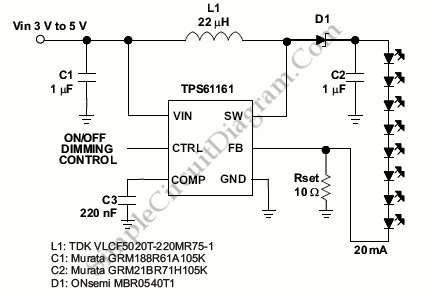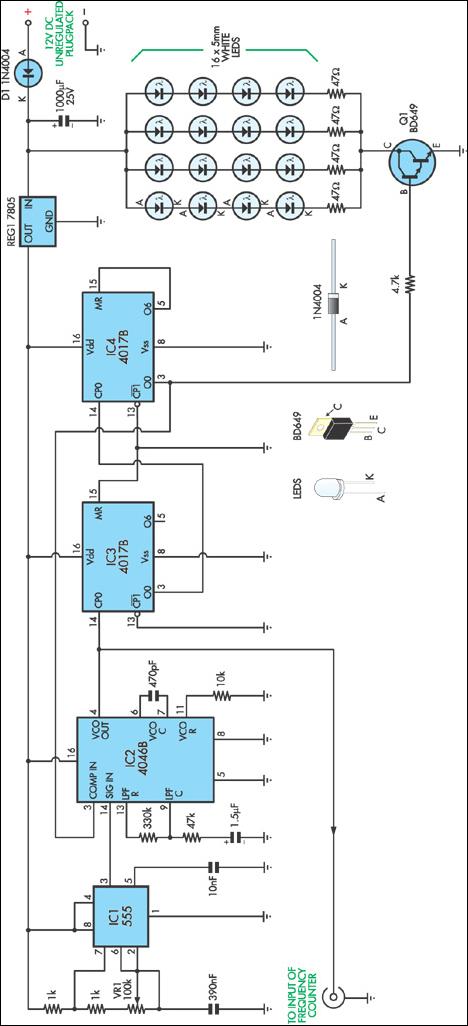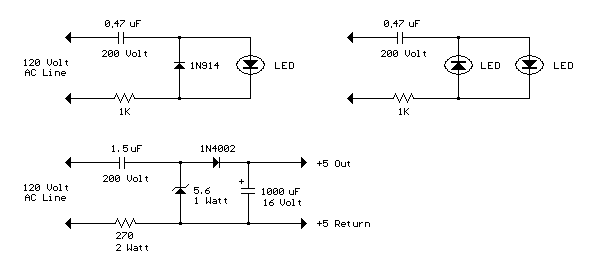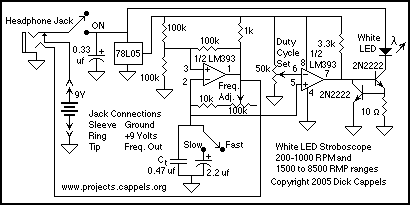
Li-Ion Driver for 8 White LEDs

A boost converter, such as the TPS61160/1, can be utilized with a 40V rated integrated switch FET to drive multiple LEDs in series. This configuration can help reduce output ripple.
The TPS61160/1 is a highly efficient boost converter designed for LED driving applications. It features a wide input voltage range, typically from 2.3V to 16V, making it suitable for various power sources, including batteries and low-voltage power supplies. The integrated switch FET rated at 40V allows for high voltage outputs, which is essential when driving multiple LEDs in series, as this configuration requires a higher forward voltage than what a single LED can provide.
The circuit operates by stepping up the input voltage to a higher output voltage necessary for the series-connected LEDs. The boost converter regulates the output current through a feedback mechanism, ensuring that the LEDs receive a consistent current, which is crucial for maintaining their brightness and longevity. Additionally, the TPS61160/1 includes features such as soft-start, which minimizes inrush current during startup, and thermal shutdown, which protects the device from overheating.
To further enhance performance, external components such as inductors and capacitors can be selected based on the desired output current and ripple specifications. The output ripple can be minimized by carefully choosing the output capacitor and inductor values, along with optimizing the switching frequency. This approach results in a stable and efficient LED driver circuit capable of powering multiple LEDs with minimal flicker and noise, making it ideal for applications in lighting and display technologies.We can use boost converter such as TPS61160/1 with a 40V rated integrated switch FET to drive up to LEDs in series. We can use it to reduce output ripple,.. 🔗 External reference
The TPS61160/1 is a highly efficient boost converter designed for LED driving applications. It features a wide input voltage range, typically from 2.3V to 16V, making it suitable for various power sources, including batteries and low-voltage power supplies. The integrated switch FET rated at 40V allows for high voltage outputs, which is essential when driving multiple LEDs in series, as this configuration requires a higher forward voltage than what a single LED can provide.
The circuit operates by stepping up the input voltage to a higher output voltage necessary for the series-connected LEDs. The boost converter regulates the output current through a feedback mechanism, ensuring that the LEDs receive a consistent current, which is crucial for maintaining their brightness and longevity. Additionally, the TPS61160/1 includes features such as soft-start, which minimizes inrush current during startup, and thermal shutdown, which protects the device from overheating.
To further enhance performance, external components such as inductors and capacitors can be selected based on the desired output current and ripple specifications. The output ripple can be minimized by carefully choosing the output capacitor and inductor values, along with optimizing the switching frequency. This approach results in a stable and efficient LED driver circuit capable of powering multiple LEDs with minimal flicker and noise, making it ideal for applications in lighting and display technologies.We can use boost converter such as TPS61160/1 with a 40V rated integrated switch FET to drive up to LEDs in series. We can use it to reduce output ripple,.. 🔗 External reference





